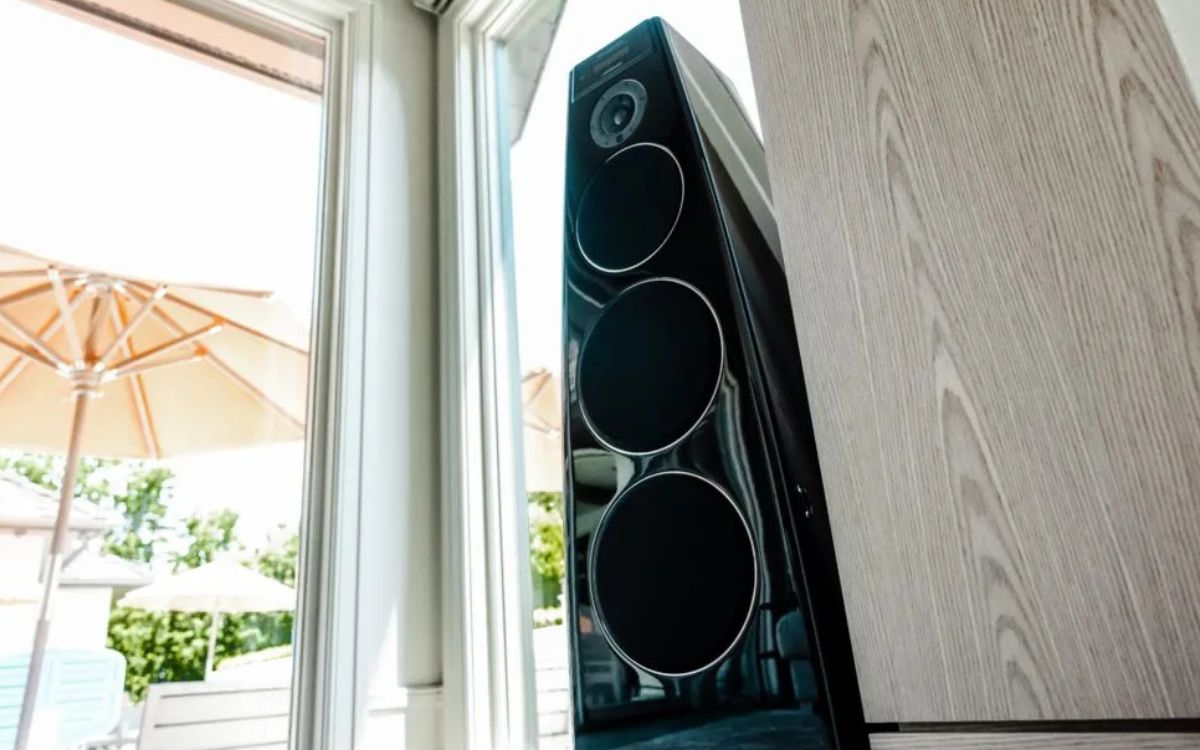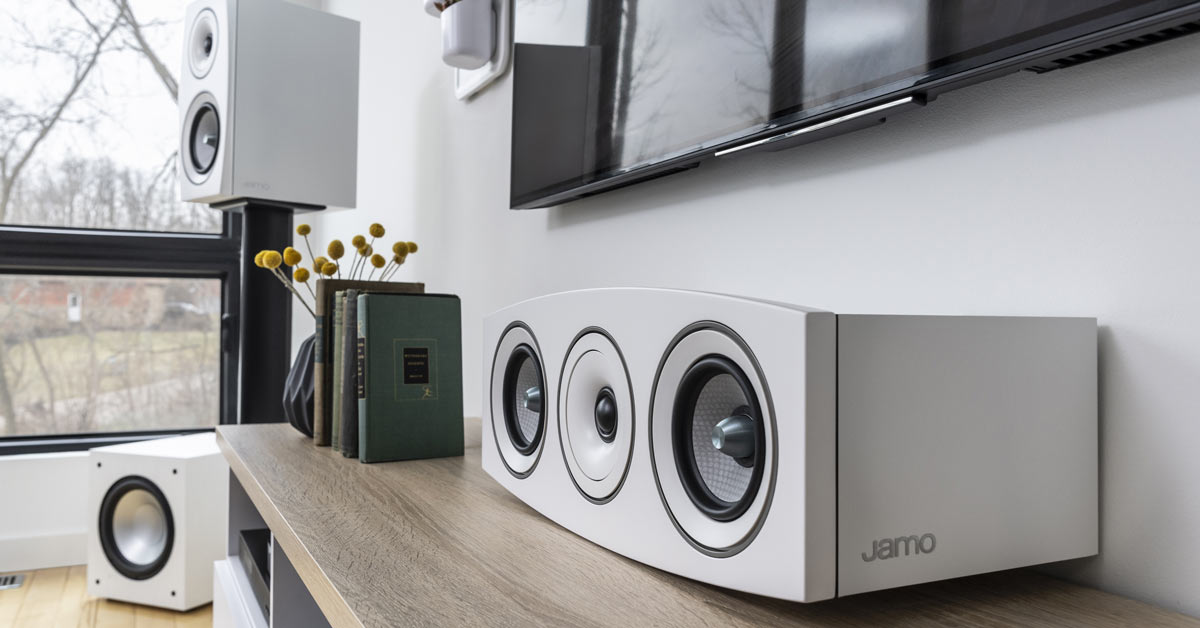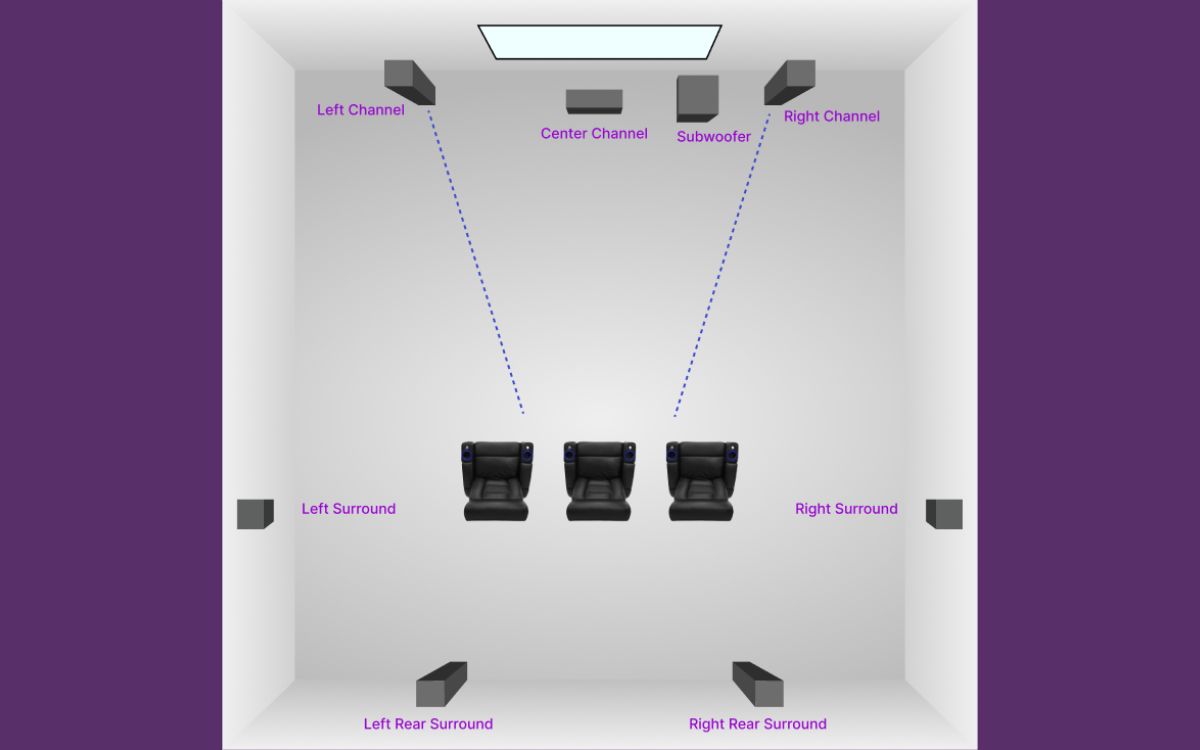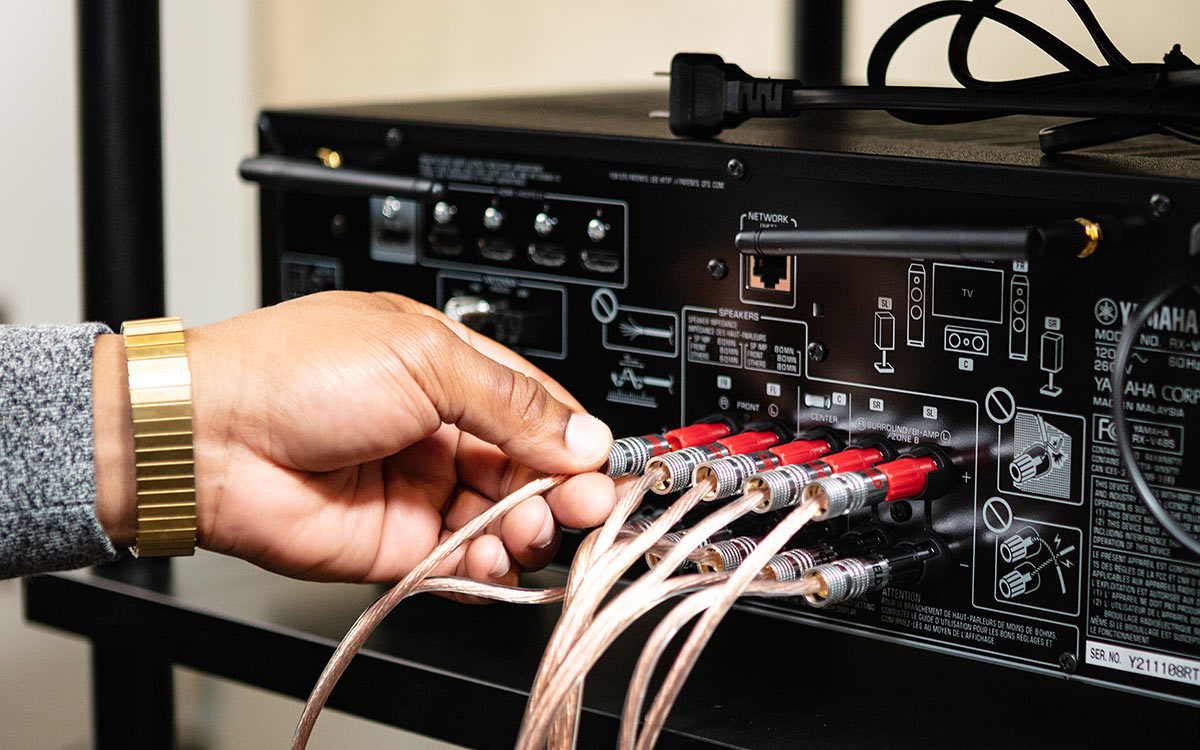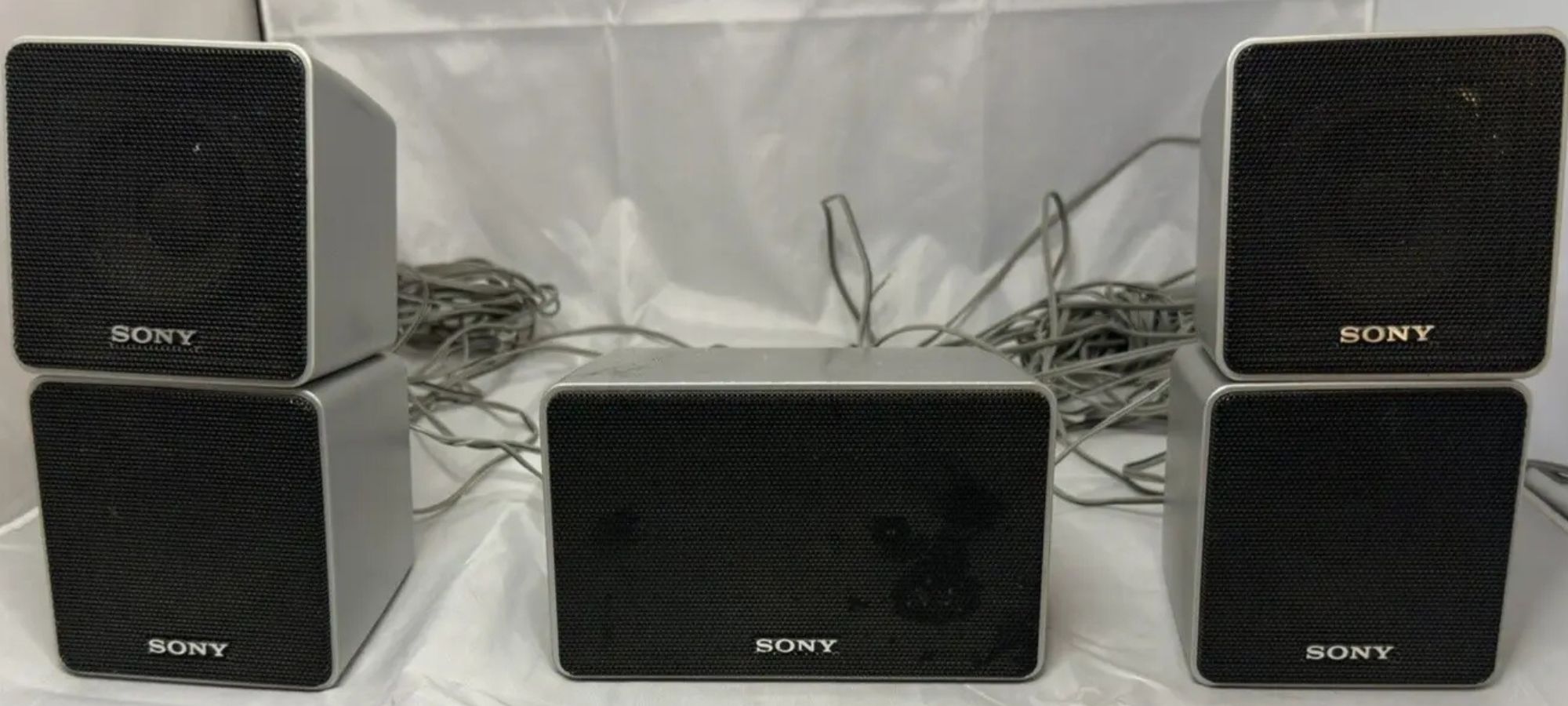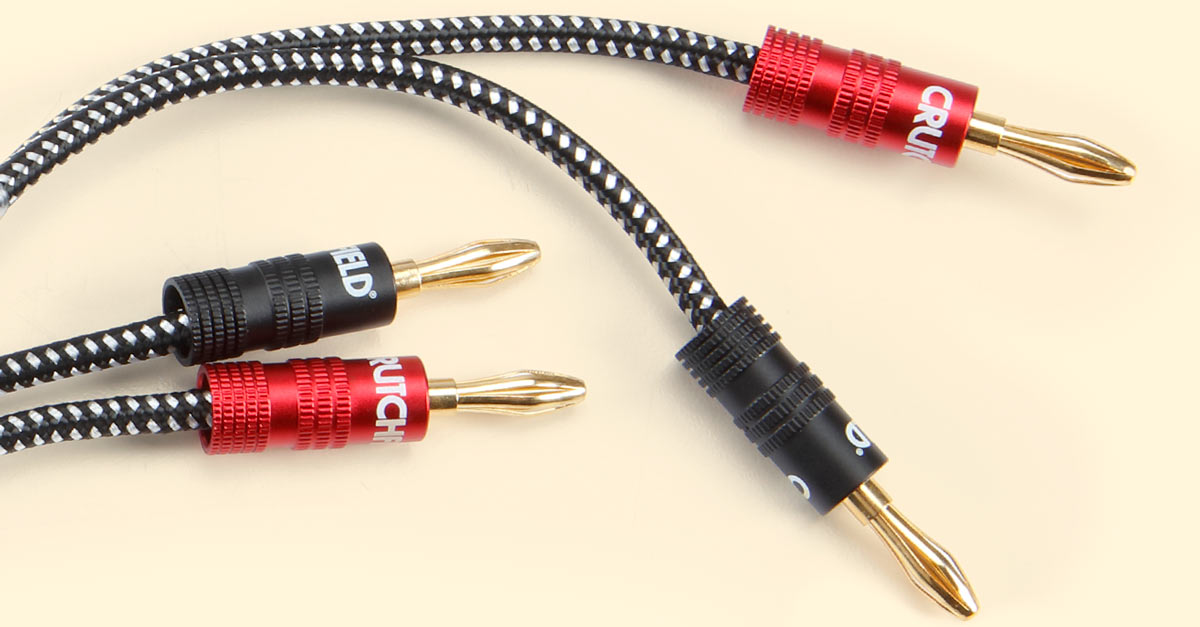Home>Production & Technology>Surround Sound>What Size Speaker Wire For Surround Sound


Surround Sound
What Size Speaker Wire For Surround Sound
Modified: January 22, 2024
Looking for the right size speaker wire for your surround sound system? Discover the perfect fit for optimal audio performance with our expert tips and recommendations.
(Many of the links in this article redirect to a specific reviewed product. Your purchase of these products through affiliate links helps to generate commission for AudioLover.com, at no extra cost. Learn more)
Table of Contents
- Introduction
- Importance of Speaker Wire in Surround Sound Systems
- Factors to Consider When Choosing Speaker Wire
- Gauge and Thickness of Speaker Wire
- Length of Speaker Wire
- Types of Speaker Wire
- Best Speaker Wire for Surround Sound Systems
- Installation Tips for Speaker Wire in Surround Sound Systems
- Conclusion
Introduction
Welcome to the world of surround sound systems! If you’re a true audio enthusiast, you know that a high-quality sound system can transform your living room into a home theater experience like no other. But have you ever wondered about the role that speaker wire plays in this immersive audio setup? In this article, we will delve into the importance of speaker wire in surround sound systems and provide you with all the information you need to make informed decisions when it comes to selecting and installing speaker wire.
Speaker wire is a vital component of any audio system, as it serves as the medium through which electrical signals are transmitted from the audio source to the speakers. It is responsible for carrying the audio signals with minimal loss or interference, ensuring that you can enjoy crystal clear sound reproduction.
Whether you’re setting up a new surround sound system or upgrading your existing one, choosing the right speaker wire is crucial to maximize the performance of your audio equipment. Factors such as the gauge and thickness of the wire, its length, and its overall quality can significantly impact the audio fidelity and overall sound experience.
In the following sections, we will explore the different factors to consider when selecting speaker wire, the various types available in the market, and provide recommendations on the best speaker wire for surround sound systems. We will also share some useful installation tips to help you achieve optimal audio performance. So, let’s dive in and unravel the world of speaker wires for surround sound systems!
Importance of Speaker Wire in Surround Sound Systems
The speaker wire in a surround sound system plays a critical role in the overall audio performance. It acts as the conduit through which the electrical signals travel from the audio source, such as a receiver or amplifier, to the speakers themselves. The quality of the speaker wire can have a significant impact on the clarity, accuracy, and overall sound reproduction.
One of the primary reasons why speaker wire is so important in a surround sound system is because it directly affects the signal transfer. Good-quality speaker wire ensures that the electrical signal is transmitted efficiently and accurately, minimizing any loss or distortion that could compromise the audio quality. This is especially crucial for multi-channel audio setups, where the precise placement and synchronization of the speakers are essential for creating an immersive surround sound experience.
Another important aspect of speaker wire is its resistance. As the electrical signal passes through the wire, there is a certain amount of resistance that can affect the power and voltage delivered to the speakers. High-quality speaker wire is designed to have low resistance, allowing for maximum power transfer and preventing energy loss. This results in cleaner and more dynamic sound reproduction, with greater detail and depth.
The build quality and construction of the speaker wire also contribute to its importance. Well-made speaker wire is manufactured using high-quality materials, such as high-purity copper or oxygen-free copper (OFC). These materials offer better conductivity and reduce signal degradation, ensuring that the electrical signals reach the speakers with minimal interference or signal loss.
In addition, using the appropriate gauge and thickness of speaker wire is crucial in ensuring optimal performance. The gauge refers to the thickness of the wire, and it determines the wire’s electrical resistance. Thicker wire with a lower gauge offers less resistance and is better suited for long wire runs or systems with higher power requirements. On the other hand, thinner wire with a higher gauge can work well for shorter distances or systems with lower power demands.
Overall, the importance of speaker wire in a surround sound system cannot be overstated. It is a critical component that impacts the fidelity, accuracy, and overall audio performance. By selecting high-quality wire, considering the appropriate gauge and thickness, and ensuring proper installation, you can enjoy a truly immersive surround sound experience that brings your movies, music, and games to life.
Factors to Consider When Choosing Speaker Wire
When it comes to choosing the right speaker wire for your surround sound system, several factors need to be taken into consideration. These factors can have a significant impact on the overall audio performance and the longevity of your system. Let’s explore the key factors you should keep in mind:
- Gauge and Thickness: The gauge of the speaker wire refers to its thickness. The gauge affects the electrical resistance and power handling capabilities of the wire. A lower gauge number indicates a thicker wire with less resistance and is suitable for longer wire runs or higher power demands. Thicker wire can help minimize signal loss, especially in larger rooms or setups.
- Length: The length of the speaker wire can impact the audio quality. Longer wire runs can introduce more resistance, leading to potential signal degradation. It’s important to measure the distance between your audio source and speakers accurately and choose an appropriate length of wire to ensure optimal performance. Considering factors such as room size and layout is vital when estimating the required wire length.
- Quality of Construction: Opt for speaker wire that is well-constructed using high-quality materials. Look for wire that features high-purity copper or oxygen-free copper (OFC). These materials offer superior conductivity, reducing signal loss and maintaining audio fidelity. Additionally, consider the insulation and jacketing of the wire. Durable insulation protects against physical and environmental damage, ensuring long-term reliability.
- Compatibility: Ensure that the speaker wire you choose is compatible with your audio equipment. Check the connectors and terminals on your speakers and audio source to verify whether you need bare wire, banana plugs, or spade connectors. Choosing wire with the appropriate connectors will ensure a secure and reliable connection.
- Budget: Consider your budget when selecting speaker wire. While it’s important to invest in good-quality wire, you don’t necessarily need to break the bank. Determine a reasonable budget and prioritize factors such as gauge and construction quality within that range.
By taking these factors into account, you can make an informed decision when choosing speaker wire for your surround sound system. Remember, selecting the right wire for your specific needs and setup will help optimize audio performance, minimize signal loss, and ensure a satisfying surround sound experience.
Gauge and Thickness of Speaker Wire
The gauge and thickness of speaker wire are crucial factors to consider when choosing the appropriate wire for your surround sound system. The gauge refers to the wire’s thickness, which affects its electrical resistance and power handling capabilities. Understanding how gauge and thickness impact performance is essential for achieving optimal audio quality.
Speaker wire gauge is measured using a numerical system, with lower gauge numbers indicating thicker wire. Commonly available gauges for speaker wire range from 12 to 18, with 12 gauge being the thickest and 18 gauge being the thinnest. Thicker wire has lower resistance and can handle higher power levels without significant signal loss compared to thinner wire.
When selecting the gauge of your speaker wire, consider the following:
- Power Requirements: Thicker wire is capable of handling higher power levels and is ideal for systems that require more power. If you have powerful speakers or plan to drive your system with high amplifier output, opt for a lower gauge wire (e.g., 12 or 14 gauge) to minimize resistance and ensure efficient power transmission.
- Wire Length: Longer wire runs introduce more resistance, potentially affecting the audio quality. If you have a large room or are planning to position your speakers far away from the audio source, thicker wire can compensate for the longer distance and help maintain signal integrity.
- Budget: Thicker wire typically costs more than thinner wire due to the increased amount of copper used. Consider your budget when selecting the gauge. If you have a smaller system or shorter wire runs, you may still achieve satisfactory results with a higher gauge wire (e.g., 16 or 18 gauge) at a more affordable price.
It’s important to note that using a gauge thicker than necessary for your system does not necessarily provide any additional benefits. While lower gauge wire offers lower resistance, allowing for better power transmission, using excessively thick wire for a low-power system or short wire runs may not result in noticeable improvements in audio quality.
In summary, the gauge and thickness of speaker wire are essential considerations for your surround sound system. Thicker wire with a lower gauge is suitable for high-power systems or long wire runs, while thinner wire with a higher gauge can work well for lower-power systems or shorter distances. By choosing the appropriate gauge based on your specific needs and budget, you can ensure efficient power transfer and optimal audio performance in your surround sound setup.
Length of Speaker Wire
The length of speaker wire is a crucial factor that can impact the performance and audio quality of your surround sound system. While it may seem trivial, the length of the wire can introduce resistance, affecting the power and signal delivered to your speakers. Understanding the impact of wire length and taking appropriate measures is essential for achieving optimal audio performance.
Here are some key considerations related to the length of speaker wire:
- Resistance: Speaker wire has inherent resistance, measured in ohms per foot or meter. As wire length increases, so does resistance. This resistance can lead to a phenomenon known as “cable attenuation,” where the signal weakens along the wire’s length. It’s important to choose the appropriate length of wire to minimize resistance and prevent signal degradation.
- Signal Loss: Signal loss occurs when electrical energy dissipates as it travels through the wire. Longer speaker wire runs generally result in more significant signal loss. This loss can manifest as a reduction in volume, loss of detail, or poorer frequency response. To maintain audio quality, it’s crucial to minimize signal loss by using the correct wire length.
- Cable Thickness: Wire thickness, or gauge, plays a role in mitigating the effects of length. Thicker wire, with lower gauge numbers, can compensate for resistance better than thinner wire. If you have a long wire run, choosing a lower gauge wire can help minimize the impact of resistance and maintain strong signal transmission.
- Room Size and Layout: Consider the size and layout of your room when estimating the required length of speaker wire. Measure the distance between your audio source (such as a receiver) and each speaker, including any walls or obstacles the wire needs to navigate. Accounting for room dimensions ensures you have sufficient wire length for proper speaker placement.
- Excess Wire: Avoid excessively long speaker wire runs and the unnecessary accumulation of excess wire. Not only can this be aesthetically unpleasing, but it also increases resistance and potential signal degradation. Trim and route the wire appropriately to maintain an efficient and tidy setup.
In most cases, it’s advisable to measure and purchase the exact wire length needed for your specific setup. If you find yourself needing an extra-long wire run, consider using thicker wire with a lower gauge to compensate for the increased resistance. This approach will help minimize signal loss and ensure efficient power delivery to your speakers.
By paying attention to the length of speaker wire and implementing appropriate measures, such as choosing the correct length and using the appropriate gauge, you can maintain optimal audio performance in your surround sound system. Remember, keeping wire runs as short as possible while considering room dimensions and using adequate wire thickness is key to achieving exceptional sound quality.
Types of Speaker Wire
When it comes to selecting speaker wire for your surround sound system, you will come across different types of wire in the market. Understanding the characteristics and differences between these types can help you make an informed decision and choose the one that best suits your needs. Here are the main types of speaker wire that you may encounter:
- Copper Speaker Wire: Copper wire is the most common and widely used type of speaker wire. It offers excellent conductivity and is available in different gauges to accommodate various power requirements. Copper wire is generally affordable and provides good performance for most home audio systems.
- Oxygen-Free Copper (OFC) Speaker Wire: Oxygen-Free Copper, or OFC, is a premium type of speaker wire that consists of copper with minimal oxygen content. This reduces oxidation and increases conductivity, resulting in better signal transmission. OFC wire is known for its superior audio performance, with improved clarity, detail, and accuracy compared to regular copper wire.
- Silver-Plated Copper Speaker Wire: Silver-plated copper wire combines the conductivity of copper with the added benefits of silver plating. Silver is an excellent conductor and can further enhance signal transmission. Silver-plated speaker wire is often used in high-end audio systems and can offer improved performance in terms of detail and tonal accuracy.
- Bi-Wire and Bi-Amp Speaker Wire: Bi-wire and bi-amp speaker wire configurations involve using separate wire paths for different frequency ranges or amplifier channels. This type of wire is typically used with speakers that have separate binding posts for high and low frequencies or multiple amplifier inputs. Bi-wire and bi-amp configurations can allow for improved signal separation and potentially better overall sound quality.
- Flat Speaker Wire: Flat speaker wire is a type of wire that is designed to be thin and flexible, allowing for discreet and easy installation in tight spaces or along walls and baseboards. It is often used in situations where concealing the wire is desirable, such as home theater setups or wall-mounted speakers.
When choosing the type of speaker wire, consider your budget, system requirements, and personal preferences. Copper wire is a reliable and cost-effective choice for most applications. If you are seeking higher audio performance and are willing to invest more, oxygen-free copper or silver-plated copper wire can offer enhanced conductivity and audio quality. Bi-wire and bi-amp wire configurations may be suitable for speakers with specific connections, while flat wire provides a neat and inconspicuous installation option.
Remember that the performance of your speaker wire ultimately depends on factors such as gauge, length, and overall construction quality. Although the type of wire can contribute to audio performance, the differences may not always be significant compared to these other factors.
By understanding the various types of speaker wire available and considering your specific requirements and budget, you can select the right wire that ensures optimal audio performance in your surround sound system.
Best Speaker Wire for Surround Sound Systems
Choosing the best speaker wire for your surround sound system can significantly impact the audio quality and overall performance of your setup. While there is no definitive “best” wire that suits every scenario, considering certain factors can help you make an informed decision. Here are some recommendations for speaker wires that are well-regarded in the audio community:
- Oxygen-Free Copper (OFC) Speaker Wire: OFC speaker wire is often considered a top choice for achieving excellent audio performance. With its high conductivity and minimal oxygen content, it helps to minimize signal loss and distortion. Many reputable brands offer OFC speaker wire in various gauges, allowing you to select the ideal wire thickness for your system.
- Silver-Plated Copper Speaker Wire: Silver-plated copper wire combines the conductivity of copper with the enhanced performance of silver plating. This type of wire is commonly used in high-end audio systems, as it can provide improved detail, transparency, and accuracy in sound reproduction.
- Brand-Specific Speaker Wire: Some home theater equipment manufacturers offer their own branded speaker wire. These wires are often designed to complement and optimize their respective audio systems, ensuring compatibility and consistent performance. If you have components from a specific brand, considering their recommended speaker wire can be a convenient option.
- High-Quality Copper Wire: Solid copper wire from reputable brands, with a suitable gauge and construction quality, can provide excellent audio performance at a more affordable price point. Look for copper wire that features good conductivity, durable insulation, and proper thickness to meet the power and distance requirements of your surround sound system.
Ultimately, the best speaker wire for your surround sound system will depend on your specific needs, budget, and personal preferences. It’s important to consider factors such as wire gauge, material quality, and your system’s requirements to make an informed decision.
Before purchasing any speaker wire, it’s recommended to read reviews, seek expert opinions, and evaluate the wire’s specifications to ensure it meets your expectations. Additionally, consider factors such as the size of your room, power requirements, and the types of speakers and amplifiers you are using to guide your decision-making process.
Remember, the speaker wire is just one element of your surround sound system, and its impact on audio quality can be influenced by other factors such as speaker placement, room acoustics, and amplifier performance. Striving for a well-rounded system with quality components will result in the best possible audio experience.
Installation Tips for Speaker Wire in Surround Sound Systems
Proper installation of speaker wire is essential to ensure optimal audio performance and prevent any potential issues in your surround sound system. Follow these helpful tips to ensure a successful and hassle-free installation:
- Measure and Plan: Before purchasing speaker wire, carefully measure the distance between your audio source (such as a receiver) and each speaker. Account for the layout of your room and any obstacles the wire needs to navigate. Planning ahead will help you determine the necessary length of wire for each speaker.
- Choose the Right Gauge: Select an appropriate wire gauge based on your system’s power requirements and wire length. Thicker wire (lower gauge) is suitable for longer runs or higher-powered systems, while thinner wire (higher gauge) can work well for shorter distances or lower-power setups.
- Strip the Wire Correctly: Use a wire stripper to remove the insulation at the ends of the wire. Be cautious not to nick or cut the conductors while stripping. Strip an appropriate length, usually around 1/2 inch, to ensure a secure and reliable connection.
- Twist Strands and Use Banana Plugs or Spade Connectors: For a more secure connection, twist the individual strands of wire together. If your speakers and audio source have binding posts or terminals, consider using banana plugs or spade connectors. These connectors offer a convenient and easy-to-use solution, ensuring a solid connection without the risk of loose or frayed wires.
- Separate and Route Wires: Keep your speaker wires separated from power lines or other audio/video cables to avoid interference or signal degradation. If necessary, use cable management solutions such as cable clips or cable raceways to route and secure the wires neatly along walls or baseboards.
- Elevate or Conceal Wires: Depending on your preference and setup, you can choose to elevate the speaker wires by running them along the ceiling or baseboards. Alternatively, you may prefer to conceal them by navigating them behind furniture or using wire concealment options like cable sleeves or in-wall conduits.
- Test and Label Connections: Once you have connected the speaker wires, test the audio to ensure proper functionality. Label each wire at both ends with the corresponding speaker or channel identification to make future adjustments or troubleshooting easier.
- Regularly Inspect and Maintain: Periodically inspect your speaker wire connections to ensure they are secure and free from any damage or corrosion. Clean the connectors if necessary, and replace any damaged or frayed wires promptly to maintain optimal audio performance.
By following these installation tips, you can achieve a clean and efficient speaker wire setup for your surround sound system. Taking the time to plan, properly route, and connect the wires will help ensure optimal audio quality and a visually appealing installation.
Remember, if you are uncomfortable or unsure about the installation process, it’s always wise to seek professional assistance. They can provide guidance and expertise, ensuring that your speaker wire installation is done correctly and safely.
Conclusion
Choosing the right speaker wire is a vital step in optimizing the audio performance of your surround sound system. By considering factors such as gauge, length, and quality of construction, you can ensure efficient power transfer and minimize signal loss. Whether you opt for oxygen-free copper, silver-plated copper, or high-quality copper wire, selecting wire that matches your system’s requirements and budget will help you achieve the best sound quality possible.
Remember to carefully measure and plan your wire runs, strip the wire correctly, and use appropriate connectors such as banana plugs or spade connectors for a secure connection. Separating and routing the wires away from power lines and regularly inspecting and maintaining your connections will ensure optimal audio performance over the long term.
While the selection and installation of speaker wire are important, it’s essential to remember that it is just one component of your surround sound system. Factors such as speaker placement, room acoustics, and amplifier quality also play significant roles in delivering an immersive audio experience.
Ultimately, choosing the best speaker wire and following proper installation practices will ensure that your surround sound system brings movies, music, and games to life with exceptional sound quality. Take the time to research and select the right wire for your needs, and enjoy the immersive and captivating audio experience that a well-designed surround sound system can provide.

